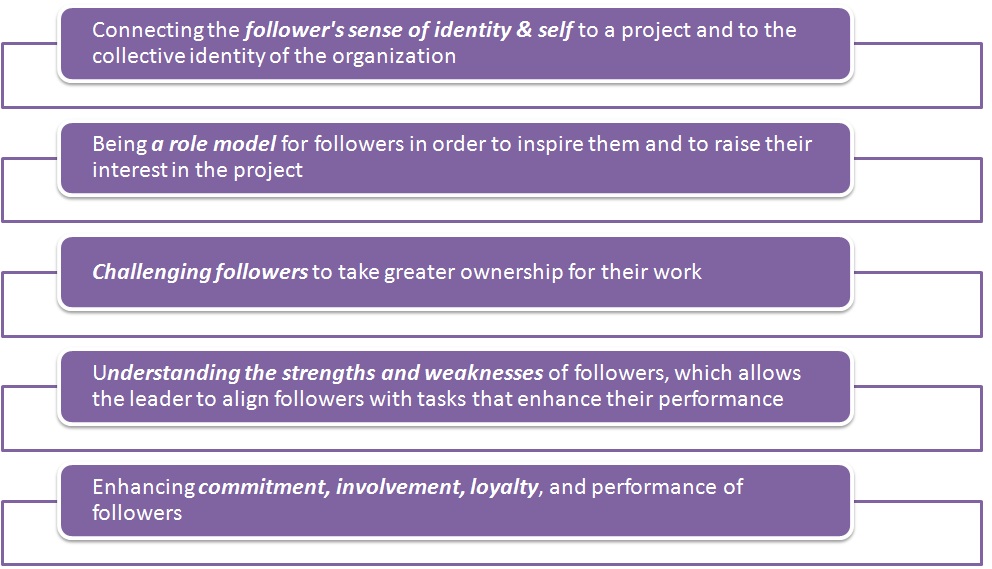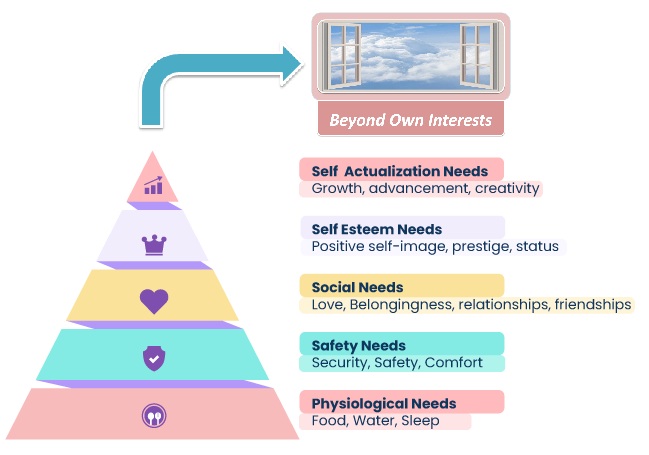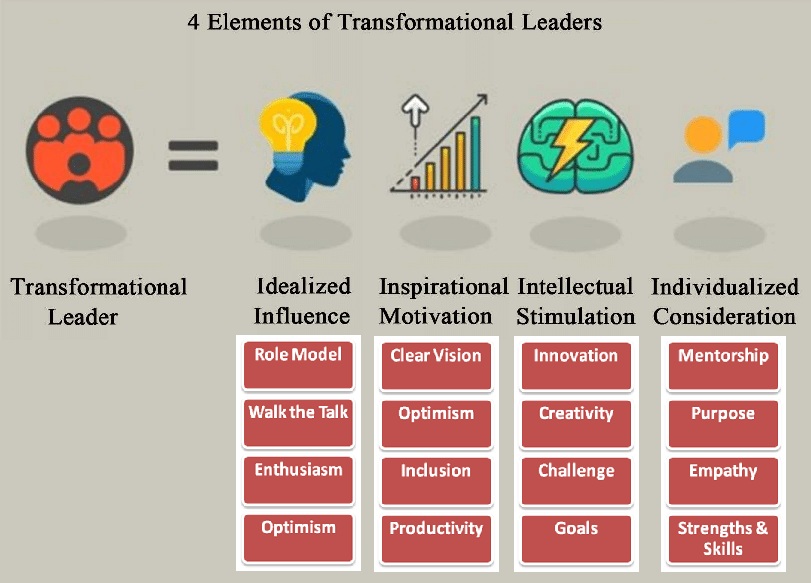
There are three broad leadership styles recognized in organizational change and leadership development circles. These may be:
Tactical leaders focus on solving straightforward problems with operations-oriented expertise.
Strategic leaders are very future-focused with an ability to maintain a specific vision while forecasting industry and market trends.
Transformational leaders focus less on making decisions or establishing strategic plans, and more on facilitating organizational collaboration that can help drive a vision forward.

Transformational leadership is a theory of leadership where a leader works with teams or followers beyond their immediate self-interests in identifying the change needed, creating a vision to guide the change through influence & inspiration, and executing the change in tandem with committed members of a group. This elevation in self-interest elevates the follower’s levels of maturity and ideals, as well as their concern for the achievement. Transformational leadership is when leader behaviors influence followers and inspire them to perform beyond their perceived capabilities. Transformational leadership inspires people to achieve unexpected or remarkable results.
Transformational leadership serves to enhance the motivation, morale and job performance of followers through a variety of mechanisms like:-

Origins of Transformational Leadership
The concept of transformational leadership was initially introduced by James Downton, the first to coin the term “Transformational leadership”, a concept further developed by leadership expert and presidential biographer James MacGregor Burns. According to Burns, transformational leadership can be seen when “leaders and followers make each other advance to a higher level of morality and motivation.” Burns also described transformational leaders as those who can not only move followers up on Maslow’s hierarchy, but also move them to go beyond their own interests. Unlike the transactional approach, it is not based on a “give and take” relationship, but on the leader’s personality, traits and ability to make a change through example, articulation of an energizing vision and challenging goals.

Later, researcher Bernard M. Bass defined transformational leadership based on the impact that it has on followers. Transformational leaders, Bass suggested, garner trust, respect and admiration from their followers. The extent to which a leader is transformational, is measured first in terms of his influence on the followers. The followers of such a leader are willing to work harder than originally expected. Transformational leadership makes transactional leadership more effective. Transformational leadership encompasses several different aspects, including:

There are 4 components to transformational leadership, sometimes referred to as the 4 I’s:
Idealized Influence (II) – the leader serves as an ideal role model for followers. The leader “walks the talk,” and is admired for this. A transformational leader embodies the qualities that he/she wants in his/her team. In this case, the followers see the leader as a model to emulate.
Inspirational Motivation (IM) – Transformational leaders have the ability to inspire and motivate followers through having a vision and presenting that vision. They inspire followers with clarity. They convince followers with simple and easy-to-understand words, as well as with their own image. Combined, these first two I’s are what constitute the transformational leader’s productivity.
Individualized Consideration (IC) – Transformational leaders demonstrate genuine concern for the needs and feelings of followers and help them self-actualize. This personal attention to each follower assists in developing trust among the organization’s members and their authority figure(s). From this perspective, the leader can work towards training and developing a follower who is having difficulties in a job.
Intellectual Stimulation (IS) – The leader challenges followers to be innovative and creative, they encourage their followers to challenge the status quo. A common misunderstanding is that transformational leaders are “soft,” but the truth is that they constantly challenge followers to higher levels of performance.
Transformational leaders do one thing transactional leaders don’t, which is going beyond self-actualization. The importance of transcending self-interests is something lost sight of by those who see that the ultimate in maturity of development is self-actualization.
Attributes and Behaviors observed of Transformational Leaders

Characteristics of Transformational Leaders
Five major personality traits have been identified as factors contributing to the likelihood of an individual displaying the characteristics of a transformational leader.

Extroversion:- . . . The two main characteristics of extroverts are affiliation (a person’s need to feel a sense of involvement and belonging within a social group), and agency (the capacity of individuals to act independently and to make their own free choices.), which relate to social and leadership aspects of their personality, respectively. Extroversion is generally seen as an inspirational trait usually exhibited in transformational leadership.
Neuroticism:- . . . It generally gives an individual an anxiety related to productivity which, in a group setting can be debilitating to a degree where they are unlikely to position themselves in a role of transformational leadership due to lower self-esteem and a tendency to shirk from leadership responsibilities.
Openness to experience:- . . . Creative expression and emotional responsiveness have been linked to a general tendency of openness to experience. This trait is also seen as a component of transformational leadership as it relates to the ability to give big-picture visionary leadership for an organization.
Agreeableness:- . . . Although not a trait which specifically points to transformational leadership, leaders in general possess an agreeable nature stemming from a natural concern for others and high levels of individual consideration. Productivity and idealized influence is a classic ability of individuals who possess agreeableness.
Conscientiousness:- . . . Strong sense of direction and the ability to put large amounts of productive work into tasks is the by-product of conscientious leaders. This trait is more linked to a transactional form of leadership given the management-based abilities of such individuals and the detail oriented nature of their personality. Results suggest that transformational leaders might give greater importance to values pertaining to others than to values concerning only themselves.
Studies have shown that subordinates’ and leaders’ ratings of transformational leadership may not converge. According to leaders’ self‐ratings, the extroverted, intuitive and perceiving preferences favor transformational leadership. On the contrary, subordinates’ ratings indicated that leaders with sensing preference are associated with transformational leadership.
Measurement Of Transformational Leadership
One of the ways in which transformational leadership is measured is through the use of Multifactor Leadership Questionnaire (MLQ), a survey which identifies different leadership characteristics based on examples and provides a basis for leadership training. The current version of the MLQ5X includes 36 items that are broken down into 9 scales with 4 items measuring each scale.
In the MLQ5X the first 5 components – Idealized Attributes, Idealized Behaviors, Inspirational Motivation, Intellectual Stimulation, and Individualized Consideration – are considered to be transformational leadership behaviors.
***To be continued in Chapter 02 (Competencies, Attributes and Traits, Becoming a Transformational Leader, Transformational Vs Transactional Leadership, Emotional Intelligence and Transformational Leaders)- Link to Chapter -02:

Content Curated By: Dr Shoury Kuttappa.

